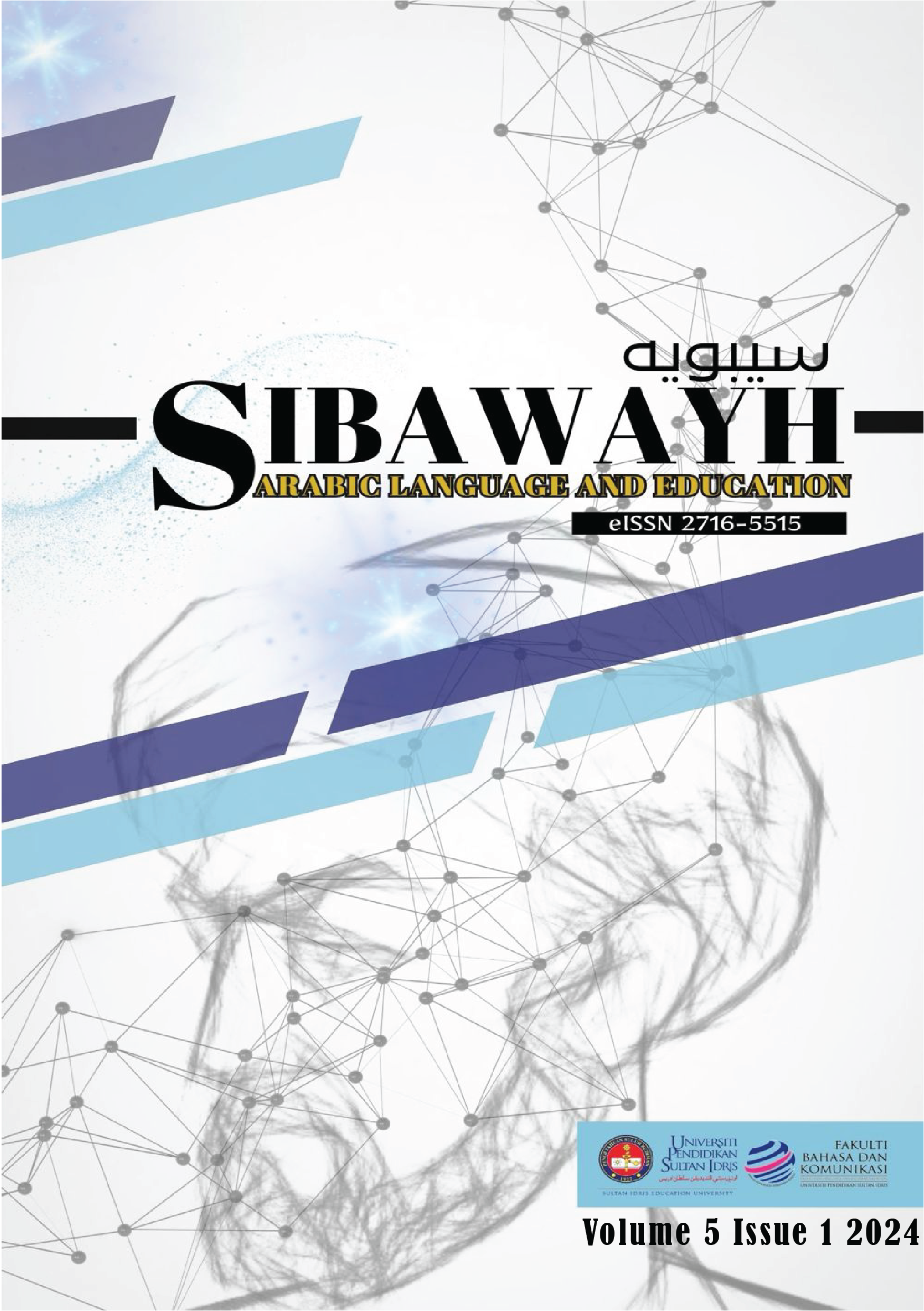فعالية نموذج الهرم المضارع في تعلم اللغة العربية لدى طلاب السنة الثاني في ولاية بوتراجايا
The Effectiveness of the Morphological Pyramid Model in Enhancing Arabic Language Acquisition Among Secondary School Students in Putrajaya
DOI:
https://doi.org/10.37134/sibawayh.vol5.1.10.2024Keywords:
فعالية التدريس, هرم المضارع, التصريف النحوي, التكنولوجيا التعليمية, الأساليب التفاعليةAbstract
تهدف هذه الدراسة إلى تقييم فعالية نموذج هرم المضارع في تحسين اكتساب مهارات تصريف الفعل المضارع لدى طلاب السنة الثانية الثانوية في مدرسة بيروني بولاية بوتراجايا. تم تحديد مجموعة من الإشكاليات التي يواجهها الطلاب، مثل ضعف القدرة على تصريف الأفعال المضارعة بدقة، وصعوبة اختيار التصريف المناسب بناءً على السياق النحوي. اعتمدت الدراسة على منهج شبه تجريبي باستخدام اختبارات قبلية وبعدية لتقييم أثر النموذج التفاعلي. شملت العينة 30 طالبًا من السنة الثانية، حيث تم تحليل نتائج الاختبارات القبلية والبعدية لقياس التطور في الأداء اللغوي. أظهرت نتائج الدراسة زيادة ملحوظة في متوسط درجات الاختبارات البعدية مقارنة بالقبلية، مما يدل على فعالية استخدام نموذج الهرم المضارع في تحسين استيعاب الطلاب لمهارات تصريف الفعل المضارع. كما توصلت الدراسة إلى أن استراتيجيات التدريس التفاعلية، بما في ذلك دمج التكنولوجيا التعليمية، توفر بيئة تعليمية محفزة تدعم تطوير مهارات الطلاب بشكل أعمق وأكثر استدامة مقارنة بالأساليب التقليدية. بناءً على هذه النتائج، توصي الدراسة بتبني أساليب تعليمية تعتمد على التفاعل والمشاركة الفعالة للطلاب، مع التركيز على استخدام أدوات التكنولوجيا الحديثة كجزء أساسي من عملية التعليم. يعد نموذج هرم المضارع وسيلة فعالة في تحسين الأداء الأكاديمي، حيث يوفر بديلاً مبتكرًا للأساليب التعليمية التقليدية التي غالبًا ما تعاني من قصور في تحقيق التفاعل النشط والفهم العميق.
This study aims to evaluate the effectiveness of the Morphological Pyramid Model in improving the acquisition of present verb conjugation skills among second-year secondary school students at Al-Biruni School in the state of Putrajaya. A set of challenges faced by the students was identified, such as a weak ability to accurately conjugate present verbs and difficulty in selecting the appropriate conjugation based on the grammatical context. The study employed a quasi-experimental approach using pre- and post-tests to assess the impact of the interactive model. The sample included 30 second-year students, and the results of the pre- and post-tests were analyzed to measure the development in linguistic performance. The results of the study showed a significant increase in the average post-test scores compared to the pre-test scores, indicating the effectiveness of using the Morphological Pyramid Model in improving students' understanding of present verb conjugation skills. The study also concluded that interactive teaching strategies, including the integration of educational technology, provide a stimulating learning environment that supports deeper and more sustainable skill development compared to traditional methods. Based on these results, the study recommends adopting educational strategies that rely on student interaction and active participation, with a focus on using modern technological tools as an essential part of the educational process. The Morphological Pyramid Model is an effective tool in improving academic performance, offering an innovative alternative to traditional teaching methods, which often struggle to achieve active engagement and deep understanding.
Keywords: teaching effectiveness, Morphological Pyramid, grammatical conjugation, educational technology, interactive methods.
Downloads
References
Abdull Majid, M. A. M., & Abdul Ghani, M. T. (2024). Penerokaan Elemen Bahan Bantu Mengajar yang menyokong Peningkatan Kemahiran Komunikasi Bahasa Arab dalam kalangan pelajar Sekolah Menengah di Daerah Setiu, Terengganu. Jurnal Pendidikan Bitara UPSI,17(1), 105–115. https://doi.org/10.37134/bitara.vol17.1.10.2024
Ali, A. M., & Othman, N. A. (2018). Meningkatkan Penguasaan Bahasa Arab Menggunakan Model Interaktif. Jurnal Kajian Bahasa Moden, 10(2), 45-58.
Aluwi, A. M. & Abdul Ghani, M. T. (2023). Penguasaan Kosa Kata Terhadap Penulisan Bahasa Arab dalam Kalangan Pelajar Sekolah Menengah Agama Khairiah: Kajian daripada Perspektif Guru [Vocabulary Mastery of Arabic Language Writing Among Khairiah Religion Secondary School Students: AStudy from The Teacher's Perspective], Sains Insani, 8(2), 294-303.
Farhan, H. S. (2019). Menilai Keberkesanan Model Piramid dalam Pengajaran Bahasa Arab. Jurnal Linguistik Arab, 11(3), 123-137.
Hassan, M. A., & Karim, R. (2019). Model Piramid dalam Pembelajaran Bahasa: Kajian Perbandingan. Jurnal Linguistik, 12(3), 77-92.
Hussain, Y., & Abdul Ghani, M. T. (2024). Penerokaan Amalan Pengajaran Terbaik dalam Meningkatkan Kemahiran Menulis Bahasa Arab: Satu Kajian Perspektif Guru Bahasa Arab di Daerah Temerloh Pahang: Exploring the Best Teaching Practices in Enhancing Arabic Writing Skills: A Study on the Perspective of Arabic Language Teachers at Temerloh District, Pahang. Sains Insani, 9(1), 85-92.
Jasni, S. R., Zailani, S., & Zainal, H. (2019). Pendekatan gamifikasi dalam pembelajaran Bahasa Arab. Journal of Fatwa Management and Research, 13(1), 358–367.
Md Nong, H. H. (2023). Elements of Teaching Aids and Environment in Teaching and Learning Arabic in Religious Secondary Schools in Marang Terengganu District. SIBAWAYH Arabic Language and Education, 4(2), 66–75. https://doi.org/10.37134/sibawayh.vol4.2.7.2023
Mufidah, N., Isyaty, I., Kholis, N., & Tahir, S. Z. B. (2018). ICT for Arabic learning: A blended learning in Istima’ II. Lisanuna: Jurnal Ilmu Bahasa Arab dan Pembelajarannya, 8(2), 119-130.
Muhammad Helmi Yakob, & Mohammad Taufiq Abdul Ghani. (2024). [MS] Cabaran Penggunaan Lughatul Fasli dalam Kalangan Guru Pelatih Bahasa Arab di Universiti Pendidikan Sultan Idris: The Challenges of Using Lughatul Fasli among Arabic Language Trainee Teachers at Sultan Idris Education University. Afaq Lughawiyyah, 2(2), 339–351.
Ramli, S., Abdul Ghani, M. T., Atoh, N., & Romli, T. R. M. (2019). Integrasi elemen Kemahiran Berfikir Aras Tinggi (KBAT) berasaskan kit media dalam amalan pembelajaran dan pemudahcaraan guru pelatih Bahasa Arab. International Journal of Language Education and Applied Linguistics, 9(1), 33–44.
Suhaimi, M. F., & Ahmad Sabri, A. S. (2023). Causes of Students Facing Difficulties in Speaking Arabic and Methods to Overcome It Among Arabic Students at UPSI. SIBAWAYH Arabic Language and Education, 4(2), 46–57. https://doi.org/10.37134/sibawayh.vol4.2.5.2023
Wismawan, K. H., Sugihartini, N., & Antara Kesiman, M. W. (2019). Pengaruh model pembelajaran Assure menggunakan media Rumah Belajar dalam upaya meningkatkan hasil belajar Teknologi Informasi dan Komunikasi. International Journal of Natural Science and Engineering, 3(3), 130–138.
Yakob, M. H. (2023). Use of Lughatul Fasli among Arabic Language Training Teachers at Sultan Idris Education University . SIBAWAYH Arabic Language and Education, 4(2), 99–106. https://doi.org/10.37134/sibawayh.vol4.2.10.2023
Downloads
Published
How to Cite
Issue
Section
License
Copyright (c) 2024 Nur Alia Misha Sharol Rizal

This work is licensed under a Creative Commons Attribution-NonCommercial-ShareAlike 4.0 International License.





